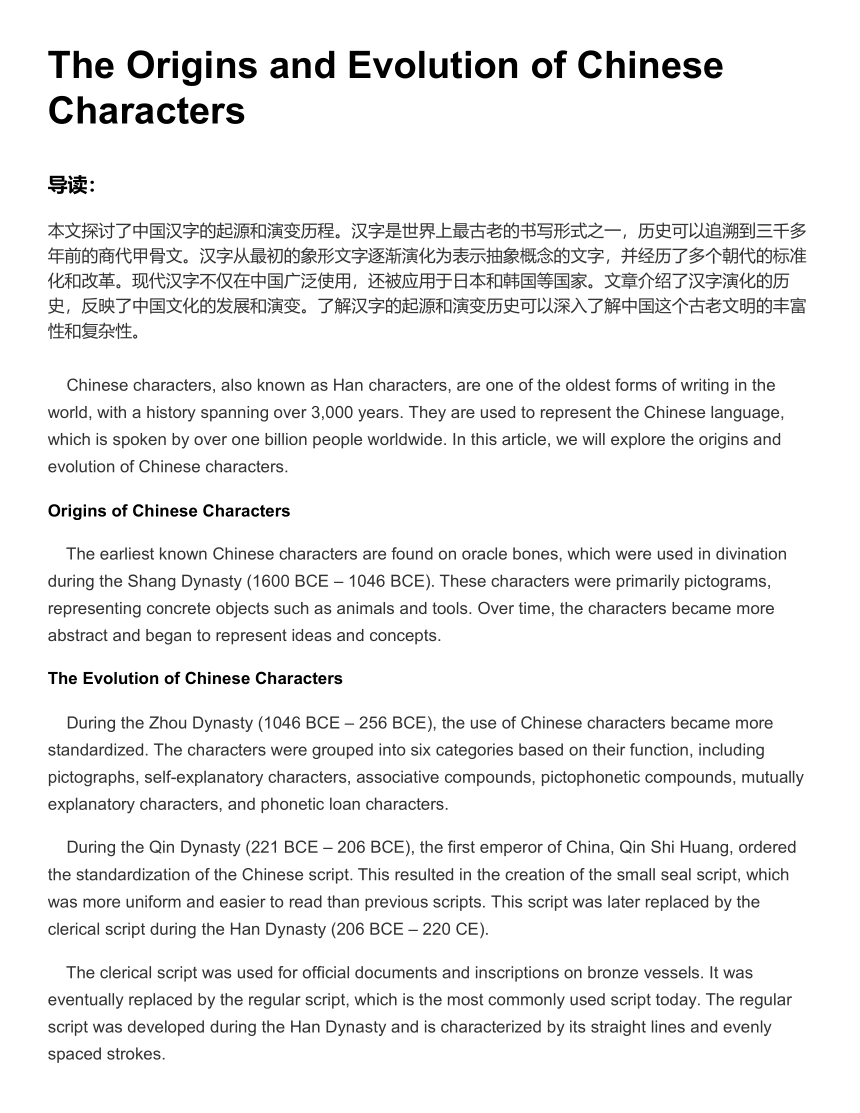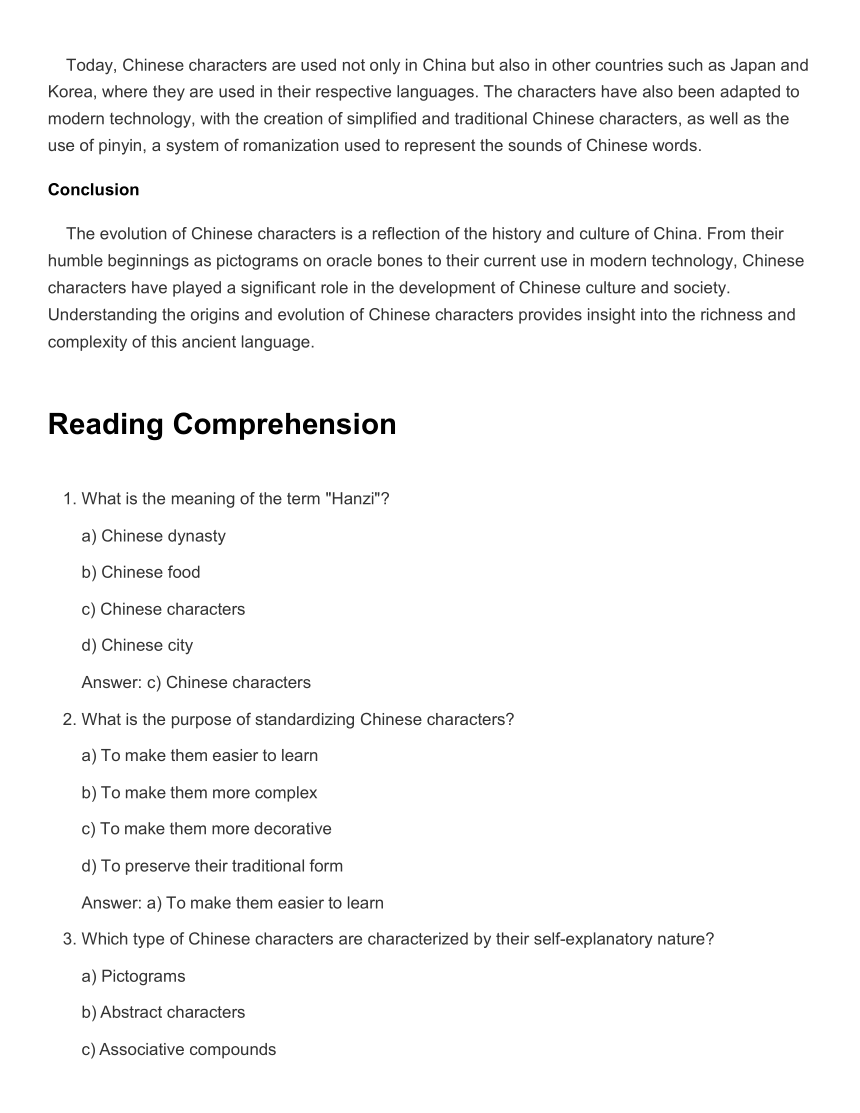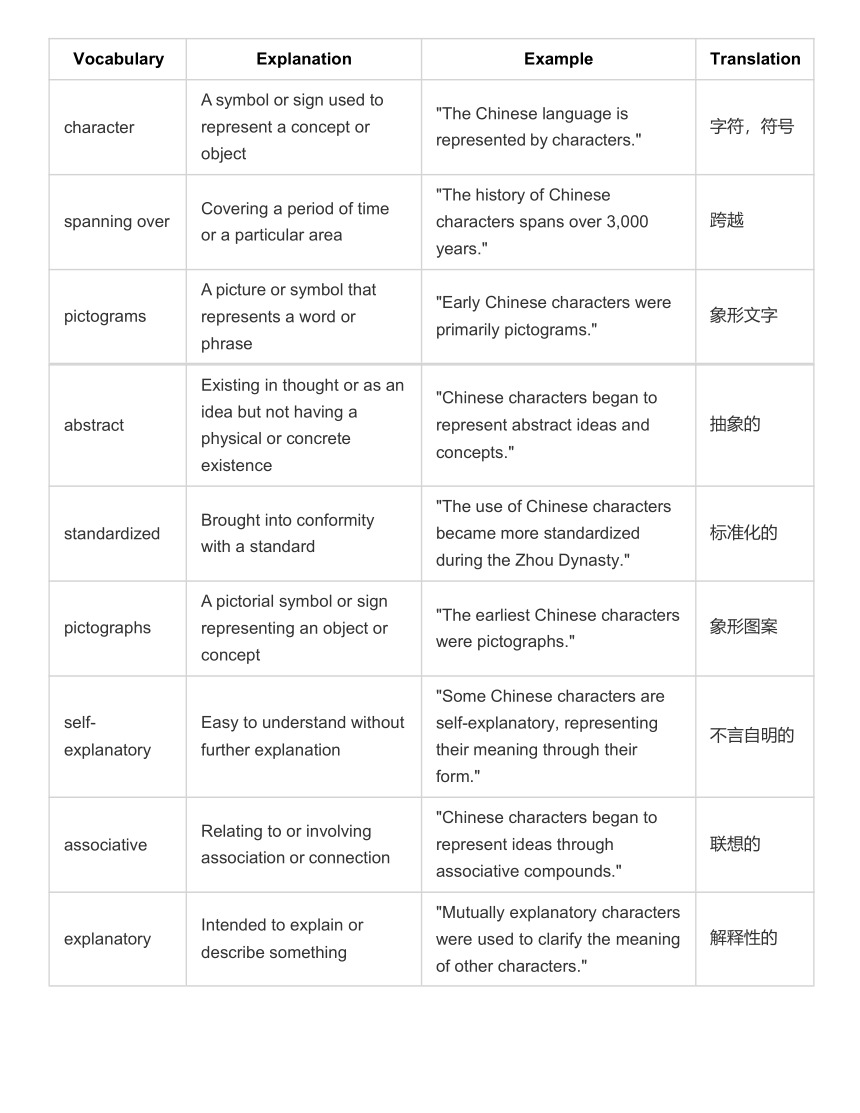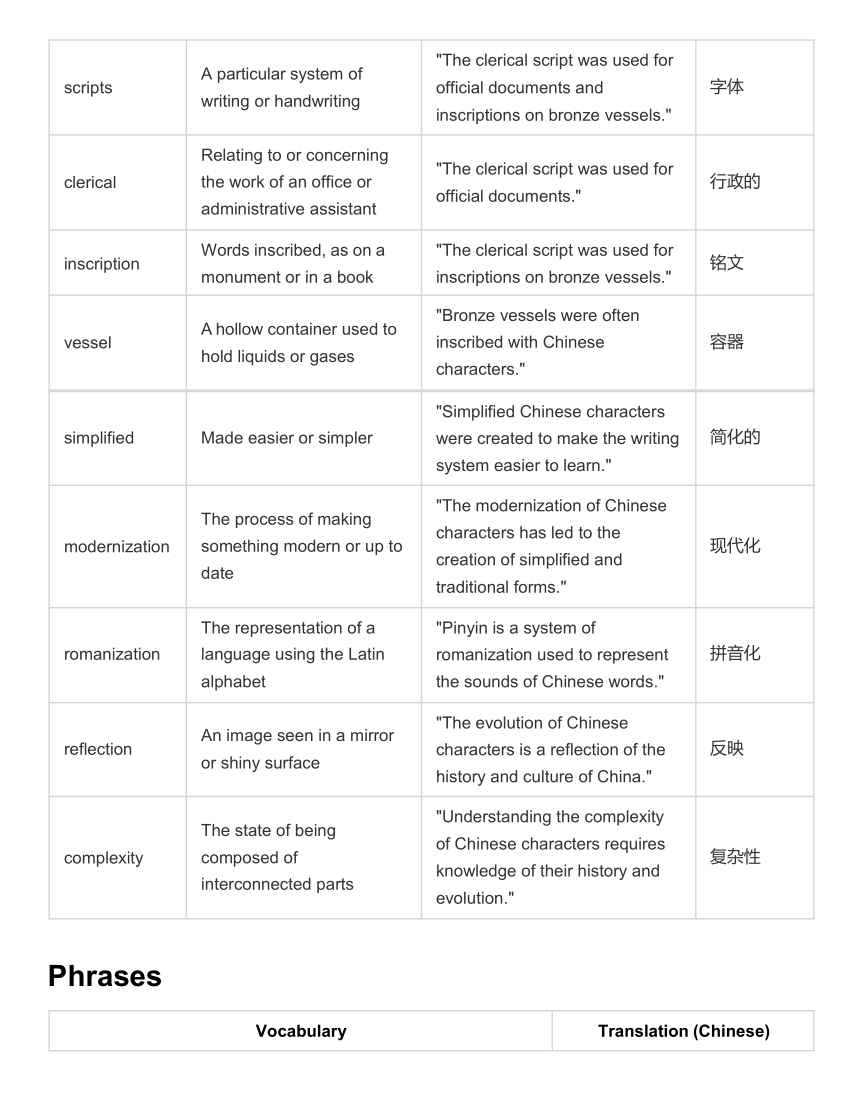2023届高三英语一轮复习中国传统文化之文字主题阅读训练(含答案)
文档属性
| 名称 | 2023届高三英语一轮复习中国传统文化之文字主题阅读训练(含答案) |  | |
| 格式 | docx | ||
| 文件大小 | 36.7KB | ||
| 资源类型 | 教案 | ||
| 版本资源 | 人教版(2019) | ||
| 科目 | 英语 | ||
| 更新时间 | 2023-02-21 00:00:16 | ||
图片预览





文档简介
The Origins and Evolution of Chinese Characters
导读:
本文探讨了中国汉字的起源和演变历程。汉字是世界上最古老的书写形式之一,历史可以追溯到三千多年前的商代甲骨文。汉字从最初的象形文字逐渐演化为表示抽象概念的文字,并经历了多个朝代的标准化和改革。现代汉字不仅在中国广泛使用,还被应用于日本和韩国等国家。文章介绍了汉字演化的历 史,反映了中国文化的发展和演变。了解汉字的起源和演变历史可以深入了解中国这个古老文明的丰富性和复杂性。
Chinese characters, also known as Han characters, are one of the oldest forms of writing in the world, with a history spanning over 3,000 years. They are used to represent the Chinese language, which is spoken by over one billion people worldwide. In this article, we will explore the origins and evolution of Chinese characters.
Origins of Chinese Characters
The earliest known Chinese characters are found on oracle bones, which were used in divination during the Shang Dynasty (1600 BCE – 1046 BCE). These characters were primarily pictograms, representing concrete objects such as animals and tools. Over time, the characters became more abstract and began to represent ideas and concepts.
The Evolution of Chinese Characters
During the Zhou Dynasty (1046 BCE – 256 BCE), the use of Chinese characters became more standardized. The characters were grouped into six categories based on their fun_ction, including pictographs, self-explanatory characters, associative compounds, pictophonetic compounds, mutually explanatory characters, and phonetic loan characters.
During the Qin Dynasty (221 BCE – 206 BCE), the first emperor of China, Qin Shi Huang, ordered the standardization of the Chinese script. This resulted in the creation of the small seal script, which was more uniform and easier to read than previous scripts. This script was later replaced by the clerical script during the Han Dynasty (206 BCE – 220 CE).
The clerical script was used for official documents and inscriptions on bronze vessels. It was eventually replaced by the regular script, which is the most commonly used script today. The regular script was developed during the Han Dynasty and is characterized by its straight lines and evenly spaced strokes.
Today, Chinese characters are used not only in China but also in other countries such as Japan and Korea, where they are used in their respective languages. The characters have also been adapted to modern technology, with the creation of simplified and traditional Chinese characters, as well as the use of pinyin, a system of romanization used to represent the sounds of Chinese words.
Conclusion
The evolution of Chinese characters is a reflection of the history and culture of China. From their humble beginnings as pictograms on oracle bones to their current use in modern technology, Chinese characters have played a significant role in the development of Chinese culture and society.
Understanding the origins and evolution of Chinese characters provides insight into the richness and complexity of this ancient language.
Reading Comprehension
What is the meaning of the term "Hanzi"
Chinese dynasty
Chinese food
Chinese characters
Chinese city
Answer: c) Chinese characters
What is the purpose of standardizing Chinese characters
To make them easier to learn
To make them more complex
To make them more decorative
To preserve their traditional form
Answer: a) To make them easier to learn
Which type of Chinese characters are characterized by their self-explanatory nature
Pictograms
Abstract characters
Associative compounds
Pictographs
Answer: a) Pictograms
What is the simplified form of Chinese characters
Traditional Chinese
Modern Chinese
Ancient Chinese
Simplified Chinese
Answer: d) Simplified Chinese
What is the system of romanization used to transliterate Chinese characters
Kanji
Hiragana
Katakana
Pinyin
Answer: d) Pinyin
Vocabulary:
Vocabulary Explanation Example Translation
character A symbol or sign used to represent a concept or object "The Chinese language is represented by characters." 字符,符号
spanning over Covering a period of time or a particular area "The history of Chinese characters spans over 3,000 years." 跨越
pictograms A picture or symbol that represents a word or phrase "Early Chinese characters were primarily pictograms." 象形文字
abstract Existing in thought or as an idea but not having a physical or concrete existence "Chinese characters began to represent abstract ideas and concepts." 抽象的
standardized Brought into conformity with a standard "The use of Chinese characters became more standardized during the Zhou Dynasty." 标准化的
pictographs A pictorial symbol or sign representing an object or concept "The earliest Chinese characters were pictographs." 象形图案
self- explanatory Easy to understand without further explanation "Some Chinese characters are self-explanatory, representing their meaning through their form." 不言自明的
associative Relating to or involving association or connection "Chinese characters began to represent ideas through associative compounds." 联想的
explanatory Intended to explain or describe something "Mutually explanatory characters were used to clarify the meaning of other characters." 解释性的
scripts A particular system of writing or handwriting "The clerical script was used for official documents and inscriptions on bronze vessels." 字体
clerical Relating to or concerning the work of an office or administrative assistant "The clerical script was used for official documents." 行政的
inscription Words inscribed, as on a monument or in a book "The clerical script was used for inscriptions on bronze vessels." 铭文
vessel A hollow container used to hold liquids or gases "Bronze vessels were often inscribed with Chinese characters." 容器
simplified Made easier or simpler "Simplified Chinese characters were created to make the writing system easier to learn." 简化的
modernization The process of making something modern or up to date "The modernization of Chinese characters has led to the creation of simplified and traditional forms." 现代化
romanization The representation of a language using the Latin alphabet "Pinyin is a system of romanization used to represent the sounds of Chinese words." 拼音化
reflection An image seen in a mirror or shiny surface "The evolution of Chinese characters is a reflection of the history and culture of China." 反映
complexity The state of being composed of interconnected parts "Understanding the complexity of Chinese characters requires knowledge of their history and evolution." 复杂性
Phrases
Vocabulary Translation (Chinese)
pictorial symbol 图象符号
physical or concrete existence 物质或者存在
standardization 标准化
mutually explanatory characters 相互解释的汉字
inscriptions on bronze vessels 青铜器铭文
hollow container 空心容器
simplified Chinese characters 简体中文
modernization of Chinese characters 汉字现代化
system of romanization 拼音化系统
evolution of Chinese characters 汉字演变
complexity of Chinese characters 汉字复杂性
form of handwriting 书写形式
words inscribed on a monument or in a book 碑文或书中铭文
traditional forms of Chinese characters 传统汉字形式
cultural significance of Chinese characters 汉字的文化意义
historical context of Chinese characters 汉字的历史背景
ideographic nature of Chinese characters 汉字的表意性质
visual elements of Chinese characters 汉字的视觉元素
stroke order of Chinese characters 汉字笔画顺序
meaning behind Chinese characters 汉字的含义
interpretation of Chinese characters 汉字的解释
use of radicals in Chinese characters 汉字中部首的使用
literacy rates in China 中国的文盲率
calligraphy styles in Chinese writing 汉字书法风格
cultural diversity within China reflected in the characters 汉字反映的中国文化多样性
traditional Chinese characters 繁体中文
simplified Chinese characters 简体中文
Outline
Introduction
Brief explanation of the topic
Importance of understanding Chinese characters
Origins of Chinese Characters
Earliest forms of Chinese writing Oracle bone script
Bronze inscriptions
Evolution of Chinese Characters
Seal script
Clerical script Regular script Running script Grass script
Types of Chinese Characters
Pictograms
Associative compounds Pictographs
Abstract characters
Standardization of Chinese Characters
Reasons for standardization
Creation of simplified characters Modernization of Chinese characters
Romanization of Chinese Characters
Introduction of pinyin
Use and importance of pinyin
Conclusion
Recap of main points
Final thoughts on the importance of Chinese characters
Key Points
Chinese characters are a complex writing system that has been used for thousands of years. The earliest forms of Chinese writing date back to the Shang Dynasty, and include oracle bone script and bronze inscriptions.
Over time, Chinese characters evolved through different scripts, including seal script, clerical script, regular script, running script, and grass script.
Chinese characters can be categorized into different types, including pictograms, associative compounds, pictographs, and abstract characters.
Standardization of Chinese characters was introduced to make them easier to learn and use, and included the creation of simplified characters and modernization of the writing system.
The romanization of Chinese characters was introduced with the creation of pinyin, which is now widely used to transliterate Chinese characters in international contexts.
Understanding the origins and evolution of Chinese characters is important for appreciating the rich cultural and linguistic heritage of China.
Reading Activity
Alex was a young Chinese-American boy who grew up in the United States. Although he was fluent in English, he was always fascinated by his Chinese heritage and was determined to learn more about the Chinese language and writing system.
One day, while browsing online, Alex stumbled upon an article about the origins and evolution of
Chinese characters. Intrigued, he began to study the earliest forms of Chinese writing, including oracle bone script and bronze inscriptions.
As Alex delved deeper into his studies, he discovered the different types of Chinese characters, including pictograms, associative compounds, pictographs, and abstract characters. He was
fascinated by the evolution of these characters over time and how they reflected the rich cultural and linguistic heritage of China.
With time and dedication, Alex became more proficient in reading and writing Chinese characters.
He even began to use them in his everyday life, from sending messages to his family in China to writing notes to his Chinese-American friends.
As Alex's knowledge of Chinese characters grew, so did his appreciation for his cultural heritage. He discovered new aspects of his identity and became more proud of his roots. He also found that his knowledge of Chinese characters was a valuable asset, both personally and professionally.
Eventually, Alex's passion for Chinese characters led him to pursue a degree in Chinese language and culture. He went on to work for a multinational corporation and became an asset in bridging the gap between China and the United States.
Alex's determination to learn about the origins and evolution of Chinese characters not only enriched his life but also opened up new opportunities for him. He was able to connect with his cultural heritage, and his knowledge of Chinese characters helped him succeed in his personal and professional life.
Reading Comprehension:
What did Li Jing discover while cleaning up her grandfather's attic
An old calligraphy brush
A stack of Chinese character books
A family heirloom
A treasure map
Answer: b) 一摞汉字书 (A stack of Chinese character books)
Why did Li Jing feel discouraged at first when trying to learn Chinese characters
She found them boring
She didn't have the time
She didn't understand their meaning
She felt they were too difficult
Answer: d) 她觉得汉字太难了 (She felt they were too difficult)
How did Li Jing finally overcome her difficulties in learning Chinese characters
She hired a tutor
She gave up
She practiced every day
She used a mobile app
Answer: c) 她每天都练习 (She practiced every day)
What did Li Jing's grandfather tell her about the importance of Chinese characters
They were just a form of writing
They held the key to understanding Chinese culture
They were outdated and irrelevant
They were not important
Answer: b) 汉字是理解中国文化的关键 (They held the key to understanding Chinese culture)
How did Li Jing feel after finally mastering Chinese characters
Confident and proud
Disinterested and bored
Frustrated and annoyed
Depressed and defeated
Answer: a) 自信和骄傲 (Confident and proud)
Words & Phrases
English Phrases Chinese
Proficient 熟练
Reading and writing 阅读和写作
Cultural heritage 文化遗产
Valuable asset 有价值的资产
Personal and professional life 个人和职业生活
Pursue a degree 追求学位
Multinational corporation 跨国公司
Bridging the gap 架起桥梁
Enriched his life 丰富了他的生活
Fascinated 着迷
Evolution 演变
Different types 不同类型
Associative compounds 联想复合
Oracle bone script 甲骨文
Bronze inscriptions 金文
Linguistic heritage 语言遗产
Enriched 丰富
Multiculturalism 多元文化
Appreciation 欣赏
Globalization 全球化
Dedication 奉献
Cultural diversity 文化多样性
Global perspective 全球视角
Multilingualism 多语言主义
Language acquisition 语言习得
Linguistic knowledge 语言知识
导读:
本文探讨了中国汉字的起源和演变历程。汉字是世界上最古老的书写形式之一,历史可以追溯到三千多年前的商代甲骨文。汉字从最初的象形文字逐渐演化为表示抽象概念的文字,并经历了多个朝代的标准化和改革。现代汉字不仅在中国广泛使用,还被应用于日本和韩国等国家。文章介绍了汉字演化的历 史,反映了中国文化的发展和演变。了解汉字的起源和演变历史可以深入了解中国这个古老文明的丰富性和复杂性。
Chinese characters, also known as Han characters, are one of the oldest forms of writing in the world, with a history spanning over 3,000 years. They are used to represent the Chinese language, which is spoken by over one billion people worldwide. In this article, we will explore the origins and evolution of Chinese characters.
Origins of Chinese Characters
The earliest known Chinese characters are found on oracle bones, which were used in divination during the Shang Dynasty (1600 BCE – 1046 BCE). These characters were primarily pictograms, representing concrete objects such as animals and tools. Over time, the characters became more abstract and began to represent ideas and concepts.
The Evolution of Chinese Characters
During the Zhou Dynasty (1046 BCE – 256 BCE), the use of Chinese characters became more standardized. The characters were grouped into six categories based on their fun_ction, including pictographs, self-explanatory characters, associative compounds, pictophonetic compounds, mutually explanatory characters, and phonetic loan characters.
During the Qin Dynasty (221 BCE – 206 BCE), the first emperor of China, Qin Shi Huang, ordered the standardization of the Chinese script. This resulted in the creation of the small seal script, which was more uniform and easier to read than previous scripts. This script was later replaced by the clerical script during the Han Dynasty (206 BCE – 220 CE).
The clerical script was used for official documents and inscriptions on bronze vessels. It was eventually replaced by the regular script, which is the most commonly used script today. The regular script was developed during the Han Dynasty and is characterized by its straight lines and evenly spaced strokes.
Today, Chinese characters are used not only in China but also in other countries such as Japan and Korea, where they are used in their respective languages. The characters have also been adapted to modern technology, with the creation of simplified and traditional Chinese characters, as well as the use of pinyin, a system of romanization used to represent the sounds of Chinese words.
Conclusion
The evolution of Chinese characters is a reflection of the history and culture of China. From their humble beginnings as pictograms on oracle bones to their current use in modern technology, Chinese characters have played a significant role in the development of Chinese culture and society.
Understanding the origins and evolution of Chinese characters provides insight into the richness and complexity of this ancient language.
Reading Comprehension
What is the meaning of the term "Hanzi"
Chinese dynasty
Chinese food
Chinese characters
Chinese city
Answer: c) Chinese characters
What is the purpose of standardizing Chinese characters
To make them easier to learn
To make them more complex
To make them more decorative
To preserve their traditional form
Answer: a) To make them easier to learn
Which type of Chinese characters are characterized by their self-explanatory nature
Pictograms
Abstract characters
Associative compounds
Pictographs
Answer: a) Pictograms
What is the simplified form of Chinese characters
Traditional Chinese
Modern Chinese
Ancient Chinese
Simplified Chinese
Answer: d) Simplified Chinese
What is the system of romanization used to transliterate Chinese characters
Kanji
Hiragana
Katakana
Pinyin
Answer: d) Pinyin
Vocabulary:
Vocabulary Explanation Example Translation
character A symbol or sign used to represent a concept or object "The Chinese language is represented by characters." 字符,符号
spanning over Covering a period of time or a particular area "The history of Chinese characters spans over 3,000 years." 跨越
pictograms A picture or symbol that represents a word or phrase "Early Chinese characters were primarily pictograms." 象形文字
abstract Existing in thought or as an idea but not having a physical or concrete existence "Chinese characters began to represent abstract ideas and concepts." 抽象的
standardized Brought into conformity with a standard "The use of Chinese characters became more standardized during the Zhou Dynasty." 标准化的
pictographs A pictorial symbol or sign representing an object or concept "The earliest Chinese characters were pictographs." 象形图案
self- explanatory Easy to understand without further explanation "Some Chinese characters are self-explanatory, representing their meaning through their form." 不言自明的
associative Relating to or involving association or connection "Chinese characters began to represent ideas through associative compounds." 联想的
explanatory Intended to explain or describe something "Mutually explanatory characters were used to clarify the meaning of other characters." 解释性的
scripts A particular system of writing or handwriting "The clerical script was used for official documents and inscriptions on bronze vessels." 字体
clerical Relating to or concerning the work of an office or administrative assistant "The clerical script was used for official documents." 行政的
inscription Words inscribed, as on a monument or in a book "The clerical script was used for inscriptions on bronze vessels." 铭文
vessel A hollow container used to hold liquids or gases "Bronze vessels were often inscribed with Chinese characters." 容器
simplified Made easier or simpler "Simplified Chinese characters were created to make the writing system easier to learn." 简化的
modernization The process of making something modern or up to date "The modernization of Chinese characters has led to the creation of simplified and traditional forms." 现代化
romanization The representation of a language using the Latin alphabet "Pinyin is a system of romanization used to represent the sounds of Chinese words." 拼音化
reflection An image seen in a mirror or shiny surface "The evolution of Chinese characters is a reflection of the history and culture of China." 反映
complexity The state of being composed of interconnected parts "Understanding the complexity of Chinese characters requires knowledge of their history and evolution." 复杂性
Phrases
Vocabulary Translation (Chinese)
pictorial symbol 图象符号
physical or concrete existence 物质或者存在
standardization 标准化
mutually explanatory characters 相互解释的汉字
inscriptions on bronze vessels 青铜器铭文
hollow container 空心容器
simplified Chinese characters 简体中文
modernization of Chinese characters 汉字现代化
system of romanization 拼音化系统
evolution of Chinese characters 汉字演变
complexity of Chinese characters 汉字复杂性
form of handwriting 书写形式
words inscribed on a monument or in a book 碑文或书中铭文
traditional forms of Chinese characters 传统汉字形式
cultural significance of Chinese characters 汉字的文化意义
historical context of Chinese characters 汉字的历史背景
ideographic nature of Chinese characters 汉字的表意性质
visual elements of Chinese characters 汉字的视觉元素
stroke order of Chinese characters 汉字笔画顺序
meaning behind Chinese characters 汉字的含义
interpretation of Chinese characters 汉字的解释
use of radicals in Chinese characters 汉字中部首的使用
literacy rates in China 中国的文盲率
calligraphy styles in Chinese writing 汉字书法风格
cultural diversity within China reflected in the characters 汉字反映的中国文化多样性
traditional Chinese characters 繁体中文
simplified Chinese characters 简体中文
Outline
Introduction
Brief explanation of the topic
Importance of understanding Chinese characters
Origins of Chinese Characters
Earliest forms of Chinese writing Oracle bone script
Bronze inscriptions
Evolution of Chinese Characters
Seal script
Clerical script Regular script Running script Grass script
Types of Chinese Characters
Pictograms
Associative compounds Pictographs
Abstract characters
Standardization of Chinese Characters
Reasons for standardization
Creation of simplified characters Modernization of Chinese characters
Romanization of Chinese Characters
Introduction of pinyin
Use and importance of pinyin
Conclusion
Recap of main points
Final thoughts on the importance of Chinese characters
Key Points
Chinese characters are a complex writing system that has been used for thousands of years. The earliest forms of Chinese writing date back to the Shang Dynasty, and include oracle bone script and bronze inscriptions.
Over time, Chinese characters evolved through different scripts, including seal script, clerical script, regular script, running script, and grass script.
Chinese characters can be categorized into different types, including pictograms, associative compounds, pictographs, and abstract characters.
Standardization of Chinese characters was introduced to make them easier to learn and use, and included the creation of simplified characters and modernization of the writing system.
The romanization of Chinese characters was introduced with the creation of pinyin, which is now widely used to transliterate Chinese characters in international contexts.
Understanding the origins and evolution of Chinese characters is important for appreciating the rich cultural and linguistic heritage of China.
Reading Activity
Alex was a young Chinese-American boy who grew up in the United States. Although he was fluent in English, he was always fascinated by his Chinese heritage and was determined to learn more about the Chinese language and writing system.
One day, while browsing online, Alex stumbled upon an article about the origins and evolution of
Chinese characters. Intrigued, he began to study the earliest forms of Chinese writing, including oracle bone script and bronze inscriptions.
As Alex delved deeper into his studies, he discovered the different types of Chinese characters, including pictograms, associative compounds, pictographs, and abstract characters. He was
fascinated by the evolution of these characters over time and how they reflected the rich cultural and linguistic heritage of China.
With time and dedication, Alex became more proficient in reading and writing Chinese characters.
He even began to use them in his everyday life, from sending messages to his family in China to writing notes to his Chinese-American friends.
As Alex's knowledge of Chinese characters grew, so did his appreciation for his cultural heritage. He discovered new aspects of his identity and became more proud of his roots. He also found that his knowledge of Chinese characters was a valuable asset, both personally and professionally.
Eventually, Alex's passion for Chinese characters led him to pursue a degree in Chinese language and culture. He went on to work for a multinational corporation and became an asset in bridging the gap between China and the United States.
Alex's determination to learn about the origins and evolution of Chinese characters not only enriched his life but also opened up new opportunities for him. He was able to connect with his cultural heritage, and his knowledge of Chinese characters helped him succeed in his personal and professional life.
Reading Comprehension:
What did Li Jing discover while cleaning up her grandfather's attic
An old calligraphy brush
A stack of Chinese character books
A family heirloom
A treasure map
Answer: b) 一摞汉字书 (A stack of Chinese character books)
Why did Li Jing feel discouraged at first when trying to learn Chinese characters
She found them boring
She didn't have the time
She didn't understand their meaning
She felt they were too difficult
Answer: d) 她觉得汉字太难了 (She felt they were too difficult)
How did Li Jing finally overcome her difficulties in learning Chinese characters
She hired a tutor
She gave up
She practiced every day
She used a mobile app
Answer: c) 她每天都练习 (She practiced every day)
What did Li Jing's grandfather tell her about the importance of Chinese characters
They were just a form of writing
They held the key to understanding Chinese culture
They were outdated and irrelevant
They were not important
Answer: b) 汉字是理解中国文化的关键 (They held the key to understanding Chinese culture)
How did Li Jing feel after finally mastering Chinese characters
Confident and proud
Disinterested and bored
Frustrated and annoyed
Depressed and defeated
Answer: a) 自信和骄傲 (Confident and proud)
Words & Phrases
English Phrases Chinese
Proficient 熟练
Reading and writing 阅读和写作
Cultural heritage 文化遗产
Valuable asset 有价值的资产
Personal and professional life 个人和职业生活
Pursue a degree 追求学位
Multinational corporation 跨国公司
Bridging the gap 架起桥梁
Enriched his life 丰富了他的生活
Fascinated 着迷
Evolution 演变
Different types 不同类型
Associative compounds 联想复合
Oracle bone script 甲骨文
Bronze inscriptions 金文
Linguistic heritage 语言遗产
Enriched 丰富
Multiculturalism 多元文化
Appreciation 欣赏
Globalization 全球化
Dedication 奉献
Cultural diversity 文化多样性
Global perspective 全球视角
Multilingualism 多语言主义
Language acquisition 语言习得
Linguistic knowledge 语言知识
